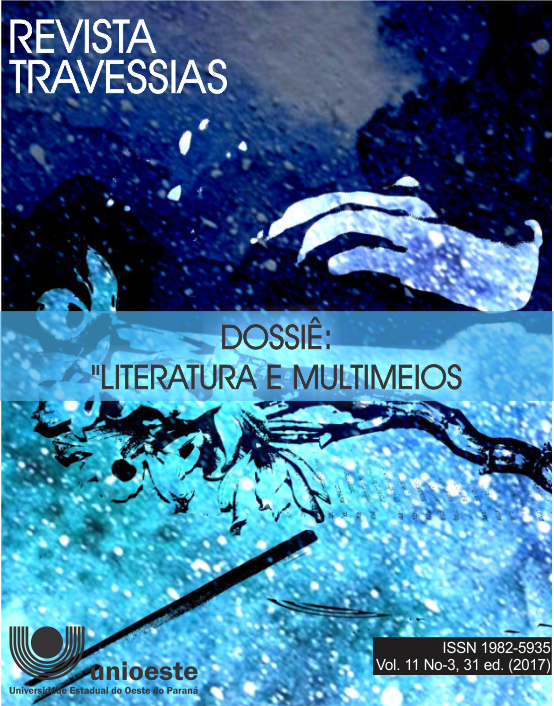A intermidialidade inerente à janela indiscreta do cinema
Palavras-chave:
Janela Indiscreta, intermidialidade, remediação.Resumo
São comuns temas voyeurísticos utilizados como recursos estilísticos na filmografia de Alfred Hitchcock. Seu filme Janela Indiscreta de 1954 é o mais proeminente exemplo dessa temática, uma vez que seu protagonista, imobilizado devido a um acidente, faz de suas observações diárias de seus vizinhos a trama principal da narrativa. Esse argumento desperta a ideia de, por vezes, o personagem estar assistindo a um filme dentro de outro, em uma produção metalinguística do renomado diretor. O presente ensaio tem como objetivo, portanto, comparar as intermidialidades que compuseram a história da arte cinematográfica com as ações desenvolvidas no decorrer do filme em análise no que diz respeito à relação entre o espectador e aquilo que é assistido. Na comparação, a história da composição intermidiática do cinema será resgatada por meio de analogias entre a narrativa de Janela Indiscreta e elementos constituintes dessa história, a saber: a relação da imagem e do som na transição do cinema mudo para o cinema falado, como nomeia o filósofo Gilles Deleuze (2005); a disjunção entre imagem e som do cinema moderno (DELEUZE, op. cit.); os diferentes artefatos (FLUSSER, 2007) que possibilitaram o surgimento do filme em 3D; e as novas remediações (BOLTER; GRUSIN, 2000) da mídia nos formatos dos jogos chamados de filmes interativos e nos próprios longas-metragens considerados interativos.Downloads
Referências
BOLTER, J. D., GRUSIN, R. Remediation: understanding new media. London: Cambridge, MIT Press, 2000.
CHRISTOFOLI, E. P. O renascimento do 3D. Contemporânea, ed. 17, vol. 9, n. 1, 2011. 138-145.
DELEUZE, G. A imagem-tempo. São Paulo: Brasiliense, 2005.
DUDENHOEFFER, L. Hitch-cockeyed: Ocular dys/function in Alfred Hitchcock’s Rear Window. Cinephile, vol. 5, n. 2, 2009. 46-53.
FLUSSER, V. O mundo codificado: por uma filosofia do design e da comunicação. Organização de Rafael Cardoso. Tradução de Raquel Abi-Sámara. São Paulo: Cosac & Naify, 2007.
MODLESKI, T. The master’s dollhouse: Rear Window. The women who knew too much: Hitchcock and feminist theory, New York, Routledge, 1989. 74-85.
MULVEY, L. Visual pleasure and narrative cinema. The sexual subject, New York, Routledge, 1992. 22-34.
SAMUELS, R. Rear Window ethics: Laura Mulvey and the inverted gaze. Hitchcock’s bi-textuality: Lacan, feminisms, and Queer Theory, Albany, State U of New York P, 1998. 109-121.
Downloads
Publicado
Como Citar
Edição
Seção
Licença
Aviso de Direito Autoral Creative Commons
Política para Periódicos de Acesso Livre
Autores que publicam nesta revista concordam com os seguintes termos:
1. Autores mantêm os direitos autorais e concedem à revista o direito de primeira publicação, com o trabalho simultaneamente licenciado sob a Licença Creative Commons Attribution que permite o compartilhamento do trabalho com reconhecimento da autoria e publicação inicial nesta revista.
2. Autores têm autorização para assumir contratos adicionais separadamente, para distribuição não-exclusiva da versão do trabalho publicada nesta revista (ex.: publicar em repositório institucional ou como capítulo de livro), com reconhecimento de autoria e publicação inicial nesta revista.
3. Autores têm permissão e são estimulados a publicar e distribuir seu trabalho online (ex.: em repositórios institucionais ou na sua página pessoal) a qualquer ponto antes ou durante o processo editorial, já que isso pode gerar alterações produtivas, bem como aumentar o impacto e a citação do trabalho publicado (Veja O Efeito do Acesso Livre).
Licença Creative Commons
Esta obra está licenciada com uma Licença Creative Commons Atribuição-NãoComercial-CompartilhaIgual 4.0 Internacional, o que permite compartilhar, copiar, distribuir, exibir, reproduzir, a totalidade ou partes desde que não tenha objetivo comercial e sejam citados os autores e a fonte.



